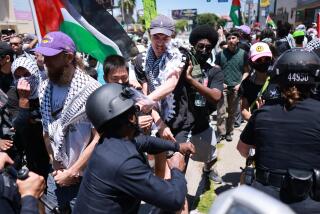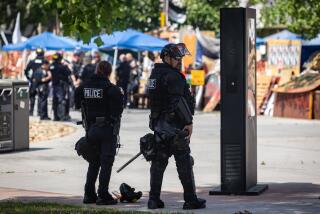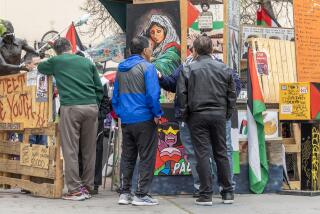LAPD, Activists Choreograph a Confrontation
At the Los Angeles Police Department’s Rampart station Wednesday, a morning march had all the earmarks of a serious confrontation: Hundreds of demonstrators vented at the police, blocked the entrance to the building and were led away in handcuffs.
Behind that apparently antagonistic scene, however, was a carefully orchestrated arrangement, a minuet of police and protesters worked out in such detail--and with enough trust on both sides--that the LAPD actually advised its critics on what crime to commit in order for them to be conveniently and safely taken into custody.
Capt. Michael Moore, who oversees the Rampart station, said he and others “choreographed” the events, down to having police suggest which crimes might make for simple, uneventful arrests. Protest leaders agreed.
“They asked what it would take to get arrested,” Moore said. “We looked up the law and gave them some ideas. They wanted to lie down in the street, but we told them they wouldn’t get arrested for that.”
Instead, they were told that if they sat on the sidewalk, Moore would declare it an unlawful assembly. If they didn’t move, Moore told them, they would be arrested.
Thirty-seven people did just that and were arrested, most carried inside the station by police officers.
That demonstration was just one in a busy day of actions intended to raise the issue of police abuse generally and to challenge the LAPD specifically. Some did not go nearly as smoothly as the Rampart event. Later in the day, police and demonstrators engaged in a series of skirmishes through downtown, capped by a particularly charged face-off outside Staples Center.
But in each instance, negotiations--some detailed and done far in advance, others improvised in the heat of the moment--prevailed over confrontation.
The cooperation between police and protesters involved in the march on the Rampart station grew out of a series of meetings, which included a visit to the home of one of the organizers, another session at the Rampart station and a final meeting in MacArthur Park, just hours before the demonstration. According to participants on both sides, the first sessions were to get to know one another and to clarify roles for the demonstration. The final meeting, early Wednesday, was called to review plans and make sure that both sides understood what the other would do in the event of trouble.
Mediators Used
Police and the protesters’ representatives played the key roles in those talks, but they were aided by the U.S. Department of Justice’s Community Relations Service.
“The whole scenario was known,” said Fermin Dominguez, a 19-year-old psychology major at Cal State Northridge who helped organize the march. “LAPD knew our plans. It was peaceful all the way. We were talking no violence, no violent civil disobedience.”
As part of the negotiations, demonstrators agreed to provide their own security. They kept the marchers in line and, when the police struggled to keep news photographers at a safe distance, the protest organizers got on the bullhorn and asked the media to step back. Most did.
In return, demonstrators asked for the opportunity to present authorities with four demands. They insisted that any Rampart-related legal settlements be paid for out of the LAPD’s budget; they asked for an end to all cooperation between the LAPD and the Immigration and Naturalization Service; they called for the appointment of an independent civilian review board to examine allegations of police misconduct; and they demanded an end to racial profiling, along with requiring the LAPD to gather statistics to determine whether and to what extent such profiling goes on today.
The peaceful end to Wednesday’s first protest came as a particular relief, given Rampart’s place at the center of an ongoing LAPD scandal--one that includes allegations of murder, brutality, perjury and theft by police officers.
.
Even on a calm day, Rampart is a busy police station. The area ranks third in the LAPD for violent crimes and violent crime arrests. The Rampart Division covers eight square miles, some of the most condensed and impoverished neighborhoods in the city. About 375,000 people live in the neighborhoods covered by the Rampart station.
Wednesday, its normal operations were overseen not just by Capt. Moore but also by a panoply of top law enforcement officials. Deputy Chief Maurice Moore and Cmdr. Tom Lorenzen, who heads the department’s convention planning unit, were on hand, as was the head of the California Highway Patrol. As the action unfolded in front of the station, Police Chief Bernard C. Parks watched from the station roof.
It came off as planned. Thirty-seven people were arrested for allegedly blocking the entrance to a public agency.
Vermont McKinney, the Justice Department’s senior mediator and team leader for operations at the Democratic National Convention, expressed satisfaction at the results.
“We got everybody on the same page,” said McKinney, whose organization was created by the 1964 Civil Rights Act. “We reached an understanding on how things were going to proceed. That was the key.”
Having successfully negotiated their way through that potential flash point, police and protesters regrouped and, hours later, shadowed one another again, this time along a march from Pershing Square to Parker Center, headquarters of the police department.
Officers stood at attention, riot helmets on, muscled arms gripping clubs firmly at their waists. Some officers clenched their jaws, others were more relaxed.
Monday night’s clash between police officers and a small band of violent demonstrators outside Staples Center still was on the mind of at least some protesters. One man had arrows painted on his stomach pointing to a scar from a “stinger round,” one of many fired at demonstrators as police cleared an area that night.
During the march, some protesters taunted police: “Come on y’all, break the silence,” the crowd chanted. “Rampart is corrupt with drugs and violence.”
The group of marchers included a tight knot of black-clad, self-proclaimed anarchists, the same group that was at the heart of Monday’s conflict. This time, however, they caused no real trouble. At one point, in fact, several of them interceded to break up a tense moment between a leftist activist and a young man marching with the crowd but carrying an anti-abortion sign.
One protester tried to take the sign from him, but a black-garbed figure from the anarchist knot stepped in and politely asked the anti-abortion protester to find another place to march.
“This is an anarchist area,” said one black-garbed figure. “We don’t really feel comfortable with that message.”
A few minutes later, the same group lit an American flag on fire and then sang a parody of the national anthem. As the flag burned, they waved their black flags and danced around. A piece of burning American flag came to rest on a news cameraman’s shoulder and he brushed it off frantically.
As the march neared Parker Center, stores closed in the Los Angeles mall, a block away. Almost all shopkeepers locked up, some securing their premises with metal security fences or doors.
But when protesters arrived in front of police headquarters, they were greeted by two rows of helmeted police guarding the entrance, backed up by a second group of officers in tight formation.
Different Results From 1992
In 1992, Parker Center was the scene of one of the LAPD’s most disgraceful moments. That afternoon, police stood by helplessly--then-Police Chief Daryl F. Gates occupied at a cocktail party fund-raiser across town--as rioters infuriated by the not-guilty verdicts in the Rodney G. King beating case tore up property and set a police department guard shack on fire.
This time, the scene was as different as the results. In 1992, a crowd that included young agitators mixed with a largely African American group of angry residents to vent their fury at racist police practices. On Wednesday, the group of protesters were less ethnically diverse than the police officers against whom they squared off.
And while protesters in 1992 came bent on causing damage, the group this time bore a confrontational message but, despite a few flashes of temper, delivered it peacefully.
“Every day we have kids being beaten down by the police,” said Jesse Ramon, a member of the organizing group. “Every day people are losing their lives to police brutality. They may have the guns, batons and handcuffs, but we have our voices.”
Cruising along with the protesters was a flatbed truck carrying a memorial of sorts to people killed by police. The truck, sponsored by a national group called the October 22 Coalition, carried two giant boards emblazoned with 2,000 names and some photos of the deceased.
When the truck parked on Los Angeles Street near the front of Parker Center, Richard Allard, 19, a student from Santa Rosa Junior College, was standing next to it, watching the protest.
“That’s my uncle up there,” he said, pointing to a photo on the truck. “His picture is the fourth one down.”
His uncle, Dale Robbins, was killed in 1996 in the Santa Rosa police station lobby, according to Allard.
“For this Stolen Lives Project, the idea is to get the word out,” he said.
The demonstrators were given a permit to protest in front of police headquarters for an hour, which they did before departing back across downtown for Staples Center.
Along the way, the carefully arranged truce that had governed the day’s events began to fray. Some incidents flared into conflict; most were quickly quashed, sometimes with the help of the Justice Department participants.
Three skirmishes erupted between 1st and 5th streets on Grand Avenue as protesters made their way back to Staples Center from Parker Center.
At one point, Kenith Bergeron, one of 15 Department of Justice community relations mediators, single-handedly kept it from erupting. He stood between the anarchists and other protesters and the police who were cocking their guns. Bergeron kept saying, “Keep moving, keep moving.”
They did.
Continuing toward Staples Center, there was more pushing and shoving. Police repeatedly cleared the sidewalk, several time resorting to rough tactics--including hitting demonstrators with batons. Demonstrators who were shoved or struck complained.
“Move!” police shouted. “Move!”
In response, the crowd chanted back at the officers: “Shame! Shame!”
Tensions continued throughout the trek, and once outside Staples Center, erupted again.
As the marchers approached, the protest organizers’ white sound truck tried to get through to the demonstration area. Police blocked the way.
Tensions rose, and some protesters began throwing plastic water bottles into the police lines.
Whitney Zak, from Oakhurst, Calif., pressed close to the police line. She was struck with batons. Another man was lying on the ground screaming, as about half a dozen police hit him with batons.
Several observers were shoved to the ground by officers with batons. One, while covering himself, was kicked several times by an officer.
After that spate of violence, police and demonstrators faced off for more than an hour, with protesters split into two groups by the police. Incensed, protesters chanted: “Whose streets? Our streets.”
Eventually, the police pulled back. As they did, they repeated their request that the crowd proceed into the designated protest area or leave.
Protesters rushed into the intersection and cheered, claiming victory. Some entered the protest area. Some left, but some remained in the intersection, leading police to declare an unlawful assembly and to order the remaining demonstrators to disperse.
As the incident wound down, one of the best-known people knocked down during the Monday melee emerged to encourage protesters to leave the area.
Hearing of the confrontation brewing near Staples Center, homeless activist Ted Hayes rushed over from the Domed Village, an encampment for homeless people several blocks away.
Once there, he got between a group of protesters and police.
“We’re here for peace,” Hayes said.
As he walked through the crowd, he was applauded by marchers, partly because he was recognized as one of those injured in Monday night’s violence. Some of the demonstrators who were not with Hayes applauded him for his peacekeeping efforts.
For five minutes, Hayes tried to coax many marchers in the intersection to follow him up the street. Then, he just began to walk away from the intersection. Many followed.
Within a few minutes, the tension had passed. Most protesters made their way to MacArthur Park, where they made plans for Thursday over plates of vegetarian food. Some followed Hayes. Others went home.
More to Read
Sign up for Essential California
The most important California stories and recommendations in your inbox every morning.
You may occasionally receive promotional content from the Los Angeles Times.











